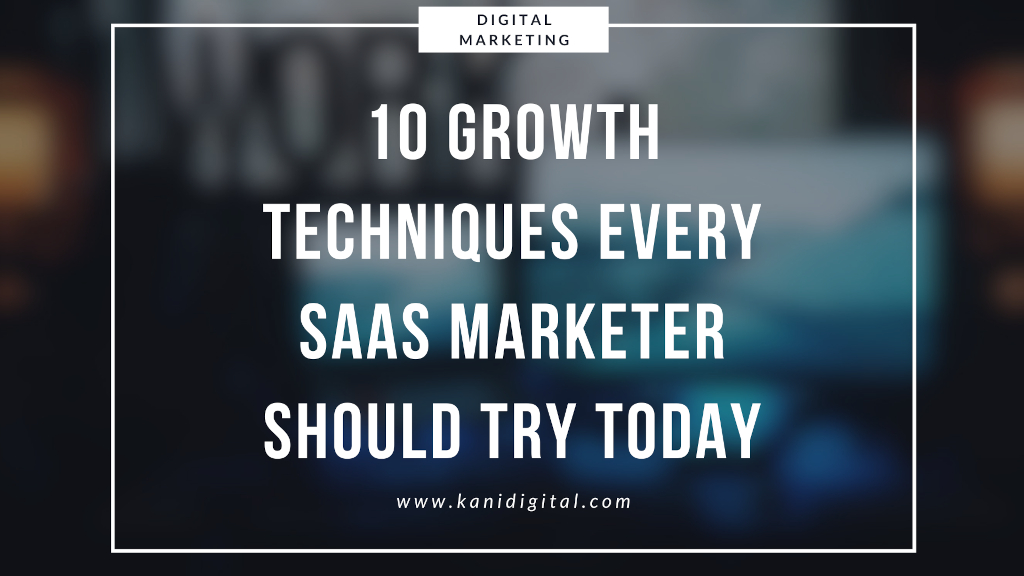10 Growth Techniques Every SaaS Marketer Should Try Today
New websites go online every day, and according to a study, in January 2021, there were 1,192,982,359 websites online. This means that it has been increasingly hard for websites to be found (organically) than it’s ever been. Marketers have to resort to creative and new growth techniques to reach their target audience, convert leads and generate leads. This is especially true for businesses in the SaaS industry where a new SaaS start-up pops every month.
What is Growth Hacking?
The phrase “growth hacking” was first used in 2010. It focuses on data-driven marketing strategies that help start-ups with marketing campaigns that have limited resources and budgets. Growth hackers are born out of the need for lean start-ups who operate with fewer resources available. Yet requiring someone who is able to take control of the company’s marketing from awareness, acquisition, conversion, retention, and referral.
Growth hackers help drive traffic to the website using new and innovative growth techniques that are data-driven and goal-oriented. Growth hacking helps SaaS businesses reach their target audience and stay competitive, especially in an over-saturated marketplace.
10 Data-Driven Growth Techniques
1. Generate Content that Engages
One of the best growth techniques to reach people and generate organic traffic is to create blogs. This helps generate engagement that leads to conversions. Blogging is one of the least expensive and fastest ways to add new content to your website. It helps you provide relevant information about the product or service. As well as showcase expertise, knowledge, and insights to your target customers.
Growth hackers first conduct in-depth keyword research and identify the frequently searched keywords of their target audience. Keyword research is important because it helps you create content targeting your ideal customers. This is based on the customers’ search queries on search engines like Google and Bing. Keyword research also allows you to create a publication calendar that is based on actual data from your target customers.
2. Create Repeatable Email Campaigns
Email campaigns and journeys can take a lot of time to plan, create assets, and build the journey. To run email campaigns effectively, you have to create emails with repeatable messaging and send them through a scalable platform. By far one of the most efficient ways to run email campaigns. Most big-name email sending platforms like Salesforce and Hubspot can be very expensive to run and maintain. That’s why most new start-ups choose scalable alternatives like Mailchimp and Autopilot to help them manage their campaigns.
Customer Relationship Management (CRM) with email marketing features helps growth hackers do more with less. This means that they no longer need to rely on developers, or need to learn to code to create emails. Integrated features like drag and drop builders, email scheduler, and contact sync also help keep tedious tasks automated. Data and analytics features help track the performance of email campaigns and conduct A/B testing. This is to help select the best-performing email campaigns to maximize email conversions.
Email marketing software also allows you to create email templates. Using these templates to quickly replicate top-performing emails and send them to another email list. This makes it easier to scale email marketing campaigns and create tailored messaging to different segments and audiences.
3. Creating Pages that Provide Information
Most marketers tend to stuff webpages with too much fluff and advertising. Usually providing no value to customers who are looking for more information about a product or service. One of the best growth techniques is to create webpages that provide relevant information. Writing informative content on your website improves your chances of getting ranked on the search engine results page (SERP). According to Google, their search algorithms prioritize web pages that provide reliable information.
One of the most efficient ways to create content that ranks well is to follow Google’s quality guidelines. Google penalizes pages that do not follow or adhere to its guidelines. Growth hackers prevent penalties by applying best practices in Search Engine Optimisation (SEO).
4. Making It Easy for Customers to Sign-Up
Another common mistake marketers make is stuffing web pages with too many forms, pop-ups, and ads. To a point where the visitors leave the site because it gets too cluttered or too intrusive. Growth marketers help web visitors convert to leads or newsletter subscribers by strategically placing forms that are easily accessible and not intrusive to the overall user experience.
The type of form on the webpage or blog should depend on where the content is relative to the customer’s journey, marketing funnel, and the content of the page. Pages that are targetted for the top of funnel leads should be as simple as possible, like only requiring an email, first name, and last name, this applies to forms like email newsletter signs. Middle-funnel content, like whitepaper downloads or PDF guides, should be a step over top-funnel forms and require more details like company name and company size, this is to turn leads into marketing qualified leads (MQLS). Bottom Funnel forms like contact us forms or “schedule a call” forms should focus on converting leads to sales qualified leads (SQL) and require more details like phone number, company size, and company industry to help the sales team identify and prepare a proposal for the lead.
5. Clear Lead Scoring between MQLs and SQLs
There is a constant tug of war between sales and marketing when it comes to leads. To ensure that no leads fall through the cracks and avoid spamming potential customers with too many emails, growth marketers create a distinct lead scoring process that helps divide the gap between marketing qualified leads and sales qualified leads.
Growth hackers create lead scores that are assigned to specific actions or interactions a lead has with the website or any other marketing assets. Most leads scores are up to 100 with SQLs having 70-100 scores and MQLs have 30-70 scores. Leads can get points for their scores depending on their level of engagement and interaction with the website. A page view on a specific page can have 10 points, opening emails 10 points, downloading guides or pdfs 20 points, or booking a phone call with 70 points. Lead scoring is an important strategy that helps ensure that the limited resources of both sales and marketing teams are focused on legitimate leads for the business.
6. Diversify Your Marketing Channels
Growth hackers engage customers on multiple channels to drive visitors to the website. This means that growth hackers cast a wide net by providing a brand presence in channels like social media platforms, popular forums, and guest posting with other sites. Targeting multiple channels allows businesses to stay up-to-date with consumer trends and allows brands to improve their reach compared to conventional marketing channels.
Engaging multiple channels also have the added benefit of reaching new customers who are not yet aware of the brand as well as creating a strong base to develop customer loyalty for existing customers/
7. Use Retargetting or Remarketing
Retargetting provides a meaningful way to connect with leads who have previously fallen off your customer journey or marketing funnel. A survey has found that only 2% of web visitors convert on their first visit. Retargetting or also known as remarketing focuses on targeting an audience who have previously visited the website.
Retargeting or remarketing has a proven track record and growth hackers can take advantage of powerful data and tools to help target customers who have fallen off the journey. Growth hackers can send specific emails with special promos to previous visitors or customers who haven’t engage with the company for at least 3 months or create social media ads that target users who have previously visited the website. These specially crafted marketing campaigns can be tailored to deliver messaging that helps convince users to revisit your site, provide a special discount or update them with the latest products and services.
8. Create Surveys and Polls
Customers love it when what they say matters to their brands. They provide a lot of opportunities for businesses to engage with their customers. Surveys and polls provide growth hackers with a golden opportunity to get feedback directly from their customers. Surveys are also a gold mine for getting insights and information about the needs and wants of your target audience.
There are a lot of online survey platforms that help automate the process like Google forms, survey monkey, and more. They provide customization options, analytics, drag and drop builders which allows growth hackers to quickly launch a survey and accurately analyze the responses.
9. Optimize for Page Speed and Mobile Usability
Big search engines like Google and Bing are making a big push for mobile usability. Google is rolling out a mobile-first practice that strongly advocates websites be interactive for mobile-first through mobile-first indexing. Ensuring mobile usability is also becoming a top priority for older websites as more and more users are using mobile phones or tablets to browse the web and visit websites.
Another important point Google is driving is page load times, Google recommends that the page load time on your website is at least 2 seconds. The 2-second mark can be a delicate balance between functionality and speed. One of the best growth techniques to bring the page load times is to reduce image sizes that are beyond the 70 to 100 kb threshold, remove unnecessary CSS or HTML lines, leverage browser caching, and more.
10. Always Monitor and Track Data
Growth hacking is always driven by data and metrics and the more data points you collect the more insight that you will have. Too much data however can cause analysis paralysis where too much time is spent collecting and analyzing data instead of using the actual data for growth.
One of the best tools to use is Google Analytics and Google Data Studio. Google Analytics is the essential tool that all growth hackers must have in their toolkit. Google Analytics serves as a data collection, aggregation, and visualization platform for websites that provide data to key metrics that describe the performance of the website like the number of users, visits, bounce rate, time on page, traffic sources, and geolocation of traffic.
Data studio on the other hand is a complementary tool to Google Analytics that goes beyond data visualization by allowing growth hackers to generate custom dashboards and blend data from different data sources. Data studio is an important tool that transforms the raw data from Google Analytics into actionable insights to help drive decisions to promote growth.
Conclusion
Growth hackers are jacks of all trades and with the right tools, software, knowledge, and experience can also be the master of many. They help drive growth despite limited resources through creative and data-driven marketing initiatives that help drive traffic to the website and promote engagement to the target audience. I hope the above growth techniques can be implemented in your business.



